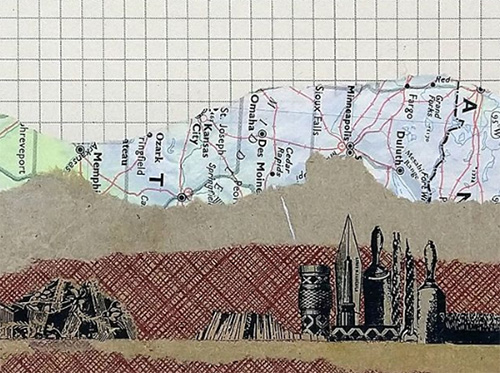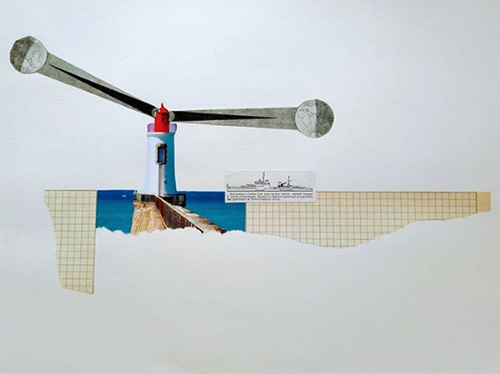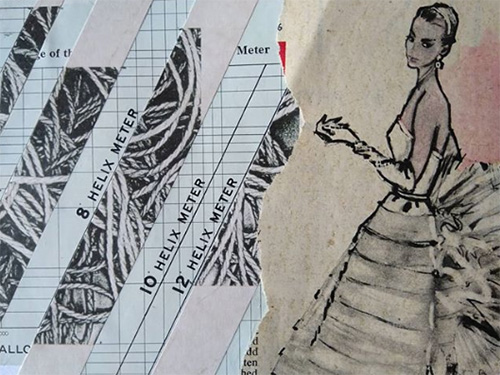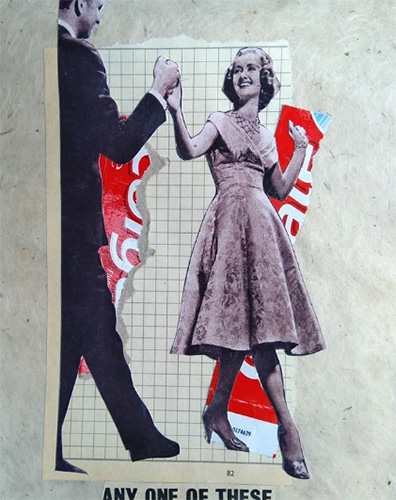interview
GEOFF LITCHFIELD
collage artist
︎ Lowestoft/United Kingdomfebruary 05, 2020


As always our first question, could you please introduce yourself a little?
I am originally from Leicester, a city in the Midlands of England, UK. I now live in Lowestoft, which is the most easterly town in Britain. I loved art from an early age. My parents were working class people who, thankfully, encouraged me by simply allowing me to draw and play with materials. I think I was about thirteen or fourteen when I first made a collage.
I trained in Fine Art, completing my degree in 1980 and a post graduate qualification in Art and Design Education in 1982. I became a teacher of art and design and have taught in a wide range of educational establishments. During this time, I always tried to maintain sketchbooks, pursue ideas and create art when possible although the commitments of working full time and family often made this difficult!
What about collage as an art form speaks to you?
Collage is immensely satisfying as a medium. It can be quite immediate and spontaneous and also encourages playfulness, allowing for chance juxtapositions and “happy accidents”. In teaching art, I found that collage was great for preventing students getting frustrated with a perceived lack of drawing skills and allowing them to express themselves quickly and freely. It is also a great medium for working in series: I often have three or more collages on the go at any one time so I can work across them without getting too precious with any one image. This way also allows you to “pause” a work to allow reflection without feeling you’ve stalled completely.
Do you work in any other media?
From my degree years onwards, much of my work had a conceptual base so photography often played a big part in terms of being able to record an idea. Textual work has always been a big thing. I am intrigued by the relationships and tensions between text and image. I also do work which involves making small interventions, be it creating a subversive text for a found booklet of instructions or leaving small pieces in the urban environment. I love playing with ideas and have always felt it important not to be too concerned as to where the boundaries are between disciplines. I think this attitude was as a result of being an impressionable student on an experimental course in the punk era!


Describe art school in the punk era. What was that like? What were you up to?
The late 70’s in Britain was a very exciting time to be a student. It was a politically charged time; the miners’ strike, riots in major cities and street clashes between the fascist national Front and the Anti-Nazi League. Margaret Thatcher was dividing the country. It felt like a time of upheaval and change. At Leicester Polytechnic the Fine Art was divided into two departments; “Painting” and “Sculpture”. Needless to say, students pushed against this and painters worked three dimensionally and sculptors painted. Experimentation was encouraged, however, and we had access to a “media-handling” area where we could explore film and sound recording (several student bands were formed here!) as well as traditional black and white photography. There was also screen printing and other printing studios.
The punk ethos was very much a “do-it-yourself” attitude; make your own fashion, make your own music, make your own art. Whilst not all of us were punks in appearance, I do think the sensibilities pervaded the work and attitudes of many of us and many of us were also pretty left-wing politically. I revisited the art school some time later and it felt like it had become a “printing school” whereas, during those years, students produced conceptual works, printed, painted, made art language pieces, filmed, animated, performed, became human sculptures, made music and even gave fictionalised lectures as art works. I remember it as a time of constantly, constantly talking, debating and arguing about ideas and art.
I was more and more seduced by conceptual works and became interested in using the banal and mundane, personification, context and how text alters the perception of an image. Thus, I found myself transporting a white painted trestle table around various locations in Leicestershire and photographing it in a variety of locations and positions! My final show largely consisted of several series of 20” x 16” photographs of the table with accompanying captions alongside an installation of mundane but malfunctioning objects in a domestic setting.
How has art education changed over the years?
Government funding cuts have had a big effect on art (and music) education at primary and secondary levels in England and Wales. Although the standard of teaching is often high, time and resources are squeezed. Unfortunately, the overloading of the curriculum in general as well as the increased focus on examination results and accountability has often led to a fear of risk taking and a reluctance to stray from a proscribed programme of study. Of course, it also depends on the ethos created by the school hierarchy. At the tertiary level, art establishments are still exciting places to be and students, in general, are expected to display a higher level of professionalism in their practise but there is great variety between institutions. Some institutions develop a definite “house style” whilst others champion individual exploration and experimentation. Unsurprisingly, the quality of the teaching staff is key. I have been fortunate to have recent experience of working at this level and have been impressed by the academic rigour that is encouraged and the creative education students receive but am concerned about external pressures on these art departments.
Is formal art education necessary? Useful? A waste of time and money? What’s your opinion on art and art education as or in an institution?
From the earliest times, humans have made songs and sounds, stories and dances, and have created and left marks. Art is fundamental. It is a way of saying “I was here” …
But …
… formal art education is absolutely necessary! We receive so much information visually, we are bombarded by imagery, moving and static. Obviously, you don’t necessarily need a formal training to be an artist (there are plenty of examples that prove that!) but everyone can benefit from a “visual education” that art and design provides and at an earlier age the better! In a time when people’s mental health is becoming a major concern and self-harm amongst the young is on the increase it is more necessary than ever. This is why it is so worrying that art and music are suffering at the primary stage. Also, a good art education is an education in critical thinking and encourages a questioning disposition and with the increase of fake news and the discrediting of expert knowledge or scientific fact by the powerful, we need more not less critical thinking!


Back to collage, what’s your thing, analog, digital, or both, and why?
All of the above! I love the physicality of cutting and pasting paper but some of my collages have been created solely from scanned material, my own photographs and internet sourced imagery. Sometimes I create a physical collage which I scan and then work on in PhotoShop. I try to not restrict myself and would rather let a piece take me where it wants to go.
How would you describe your own collages or style?
Well, that’s tricky for me really. I recently completed and posted a collage every day for a year because I needed the discipline of such a challenge but that meant that I wasn’t going to get too hung up about style or, to be honest, worrying overmuch about concepts of quality. I just allowed myself to explore everything that came to mind or to hand; minimal, quirky, satirical, autobiographical, accidental. In general, though, I’m drawn to things that develop an internal narrative and I love things that work in series. I have an on-going project which involves reworking vintage sepia prints of the Tivoli Gardens from an Italian publication and another single mixed media piece which is concerned with dissent, disorder and oppression. These pieces are long term and demand a different approach to quality.
What is the Tivoli Gardens project and where can we see it?
The Tivoli Gardens project is not online anywhere as I do not intend to post/exhibit it until it’s complete (and I don’t know what that means yet!). I have however, included a few images to show work in progress. It has involved taking the book apart and physically collaging on the pages. They will be reassembled, possibly in a new order to create a free-form surreal(?), non-linear(?) narrative. There will be a tangential, disrupting (?) text on the facing blank pages. Parallel to this will be a digital version based on PhotoShopped images from scans of the manual collages.



You are the joint custodian of the George Kaplan collection. Who is George Kaplan?
Ha! George Kaplan was a character from a Hitchcock film who doesn’t exist. Many years ago, as Fine Art students, six of us invented a fictitious artist with that name and faked his artwork, biography and related ephemera. (Ironically, I have recently discovered a real artist of that name with a profile on Saatchi Art). Some time ago, I resuscitated the bogus George to allow me to post artwork in a variety of media semi-anonymously on Facebook. It was a way of being free. The character may have been fake but the intention was that the work was always executed with integrity. For the last twelve months or so, “George Kaplan” has been a vehicle to post the progress of an on-going collaborative collage project called “The Splendid Fabric Assents.”


The collaboration is in the form of a game. How many are you? And how did you come up with the idea?
Yes, it’s a game played by picking a series of “Chance” cards shared between the participants that contain a set of instructions ranging from the literal to the absurd. They are designed to be reflective and encourage creative and lateral thinking. They are a definite nod towards Brian Eno and Peter Schmidt’s “Oblique Strategies”. The name is a fragment from playing the Surrealists’ “Exquisite Corpse” game. The original idea (not that anything is truly original …) developed from a practical mixed media project designed by myself given to groups of 16 to 18 year old students to develop risk taking and creativity. I revised it so that it could work as a collaboration between participants who were not geographically close. I approached an old friend, artist/photographer Mike Tupling, who spends a lot of his time in France and between us we agreed a starting point (a loose collage of three pages from a random magazine. The pages were chosen by taking the house numbers of places I had lived in as a student). We both have an identical set of cards and draw one per move. Each player is free to work with any combination of analogue and digital processes. When we are content with the stage of development, it is emailed to the other person with an accompanying rationale for the move. A copy of the collage is posted on George Kaplan’s Facebook page and a high-resolution image is retained by the sender. We have a loose time scale as we only have to satisfy ourselves but obviously the larger the number of players the more the need for a tighter schedule. We set an arbitrary and provisional number of 12 moves for the first game.
What do you feel is the value of collaboration with other artists?
When musicians perform in a band, the whole becomes greater than the sum of its parts. It can be the same with a collaboration; it’s an enriching and rewarding experience that can’t work in the same way as a solitary one. Like the card instructions intend, you have to respond to unexpected developments which challenge you and this can become a growth experience.


How about challenges? What happens when a joint piece of art isn’t going in a direction you like? Or rather, because dislike in itself isn’t really an issue, what if it is going somewhere you really, actively dislike or object to, be it aesthetically or thematically?
Any collaborative enterprise has to have a set of guidelines. We have called them “Rules” because we liked the idea of imitating the sets of rules contained in board games. For any game to be fruitful, participants have to work with those constraints so any drawn card must be interpreted with integrity within the move. Participants are free to add more elements of their own and to make aesthetic judgements but the whole nature of this as a project is that process is far more important than outcome so in many respects you are already putting like/dislike to one side. The chance elements in the game create opportunities rather than inconveniences.
Any thoughts on art and ego in this context?
It depends how comfortable you are with abdicating elements of control. There can be a tendency for Western artists and musicians to feel that they have to be in control of everything or to know exactly why something is in a work. Others are more relaxed about the idea of “letting go” and allowing a process to have a prime role. I used to be obsessed about everything having to contain a clear intellectual meaning and purpose, now I am happy to try to create contexts where meaning develops more organically and/or haphazardly. In this regard, ego takes a back seat and, hopefully, open-mindedness and acceptance come to the fore. Thus, when the game is played with several participants, it promotes an environment that is in keeping with the collective ideal. I firmly believe that this is how we grow as people too …
Geoff is currently developing a version of “The Splendid Fabric Assents” game for Paris Collage Collective. Keep an eye on our projects and news sections for more information.
Geoff Litchfield on Instagram
interview: Petra Zehner